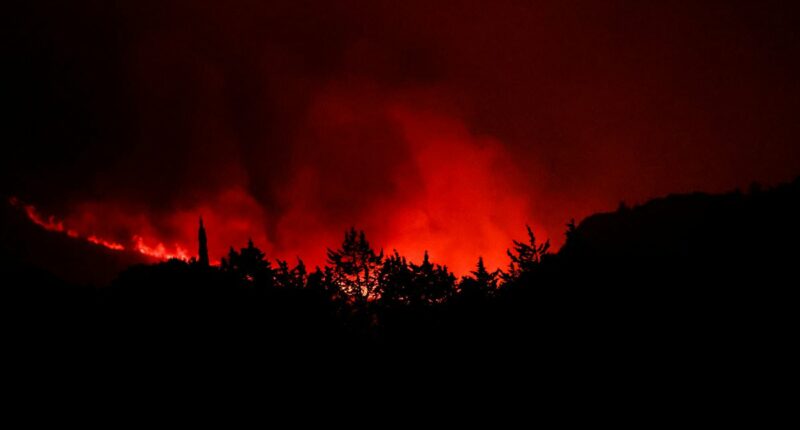Share this @internewscast.com
Europe is contending with a new surge of devastating wildfires as intense blazes ravage France and Spain, prompting alarmed tourists to evacuate and leading to the tragic death of a woman in her home.
This occurs as a relentless heatwave maintains its grip on Europe, with several nations experiencing record-high temperatures, as scientists express concern about the escalating effects of climate change.
The swiftly spreading wildfire in southern France has consumed around 13,000 hectares of terrain, an area comparable to the size of Paris, local authorities reported on Wednesday.
The fire, thought to have ignited from a discarded cigarette butt, has either destroyed or harmed 25 homes in the Aude department, where 1,500 firefighters are striving to subdue it.
A woman died in her home and two people were injured, one of whom is now in critical condition with severe burns, according to the Aude prefecture.
This fire represents the largest wildfire France has confronted this summer. Southern European countries such as Spain, Portugal, and Greece have encountered numerous large fires in recent months due to the combination of intense heat and arid conditions.
Meanwhile, a dramatic forest fire near a beach resort in southern Spain also forced the evacuation of tourists and locals.
Multiple aircraft have been roped in to tackle the inferno, which took hold in Cadiz in Andalusia on Tuesday afternoon.

Trees burn during a dramatic wildfire near Narbonne, southern France on August 6

Cars drive past a fast-moving wildfire in a Mediterranean region of France near the Spanish border

Meanwhile in Spain, the flames are spreading in the hills of Torre de la Peña, behind the hugely popular resort of Tarifa
The woman who died in France was a 65-year-old who lived alone, according to French media, whose house was engulfed by the flames.
‘The resident was determined to remain in her house, and regrettably, the fire rapidly approached and overwhelmed her home,’ said Xavier de Volontat, the mayor of Saint-Laurent-de-la-Cabrerisse.
‘The fire is advancing in an area where all the conditions are ripe for it to progress. We are monitoring the edges and the back of the fire to prevent flare-ups,’ said Lucie Roesch, secretary general of the Aude prefecture.
She said firefighters are expecting to receive aerial support at dawn, but warned ‘this fire will keep us busy for several days. It’s a long-term operation’.
The fire’s advance slowed overnight due to high humidity levels, she added.
One person was seriously burned and another injured, the prefecture said, adding that seven firefighters were also hurt.
Camping grounds and one village were partially evacuated, and several local roads have been closed.
‘All of the Nation’s resources are mobilised,’ French President Emmanuel Macron said on X, while calling on people to exercise ‘the utmost caution’.

Tourists sit on the beach as the smoke from wildfires raging in the Aude department is seen from the Mediterranean coast in Banyuls-sur-Mer, southwestern France, on August 5

The wildfire in the Corbieres massif, southern France, where one person has died and several others have been injured

This photo provided by Meteo France shows smoke billowing from a wild fire in southern France, Tuesday, August 5

Trees burn during a wildfire at sunrise near Saint-Laurent-de-la-Cabrerisse, near Narbonne, southern France

A water bomber plane dropping water on the wildfire in the Corbieres massif, southern France

This photograph shows burnt vehicles in an area devastated by a wildfire near Fontjoncouse, southwestern France

Burnt veichles are seen due to a wildfire that broke out in Saint-Laurent-de-la-Cabrerisse, southwestern France

This photograph shows the remains of a home where a woman died due a wildfire brokes out in Saint-Laurent-de-la-Cabreriss

A burnt van is seen in front of a home burned due to a wildfire brokes out in Saint-Laurent-de-la-Cabrerisse

A firefighting vehicle drives past houses near an area devastated by a wildfire near Fontjoncouse, southwestern France
The fires have spread through a stretch of land roughly equivalent to the size of the French capital between Carcassonne and Narbonne.
Four Canadairs, two Dashes and a water bomber helicopter resumed around 7 am on Wednesday morning to fight the flames.
The Aude department has seen an increase in areas burnt in recent years, aggravated by low rainfall and the removal of vineyards, which used to help break the progression of fires.
Some 100 police officers joined the firefighters and aerial support to battle the flames.
At 10:20 am on Wednesday, the Ribaute mayor said the fire in France was under control, but acknowledged the scale of devastation.
‘It’s true that yesterday was a particularly difficult day,’ Mr Coste said to French media. ‘We know that two outdoor sheepfolds – one of which is inhabited – were completely or partially destroyed.’ Meanwhile in Spain, the flames are spreading in the hills of Torre de la Peña, behind the hugely popular resort of Tarifa.
According to the Andalucia firefighter service INFOCA, there are gusts of 20-25km/hr that are favouring the fire’s spread.

Multiple aircraft have been roped in to tackle the inferno, which took hold in Cadiz in Andalusia on Tuesday afternoon
The fire is snaking very close to the N-340 highway and the Estrecho Natural Park – the former of which has been partially closed between Las Piñas and Pedro Valiente.
Meanwhile, all bars, restaurants or hotels have been evacuated between La Peña and Casas de Porros, reports local newspaper Europa Sur.
According to the local police, the fire started in a motorhome at the Torre la Peña campsite, which also had to be evacuated.
The flames then blew westward, away from the campsite, and spread rapidly through a hilly and grassland area where homes and tourist establishments are scattered – including the Wawa Hotel, which is reported to have been affected by the fire.
Several beach bars and ‘chiringuitos’ have also been evacuated due to the large amounts of ash being carried down to the shore.
The blaze was first reported at around 4pm on Tuesday.
The current firefighting operation involves five helicopters, two water-carrying planes, a coordination plane, five forest fire ground crews and more.
Tarifa is often branded a ‘surfer’s paradise’ due to its extremely wide beaches and tall waves.

According to the Andalucia firefighter service INFOCA, there are gusts of 20-25km/hr that are favouring the fire’s spread

The blaze was first reported at around 4pm on Tuesday

According to the local police, the fire started in a motorhome at the Torre la Peña campsite, which also had to be evacuated
It comes just days after blazes erupted in Portugal, Greece, and Spain, while tornadoes struck tourist hotspots in parts of Spain and Switzerland.
Thousands of firefighters battled a dozen wildfires raging in northern Portugal and central Spain into Wednesday, in the largest wave of blazes in the Iberian Peninsula so far this year following weeks of summer heat.
The largest wildfire burned in the wooded, mountainous Arouca area – some 300 km (185 miles) north of Lisbon – since Monday, leading to the closure of the scenic trails of Passadicos do Paiva, a popular tourist attraction.
Some 800 firefighters and seven waterbombing aircraft tackled the blaze.
‘There was a huge effort during the night, so now we have a somewhat calmer situation,’ Civil Protection Commander Helder Silva told reporters, cautioning that shifting strong winds and a difficult terrain meant their work was far from over.
‘It’s a very large wildfire in areas with difficult access,’ he said.
Further north, a blaze raged from Saturday in the Peneda-Geres national park near the Spanish border, enveloping nearby villages in thick smoke that led to orders for residents to stay at home.
Portuguese firefighters managed to control two large fires that started on Monday in the central areas of Penamacor and Nisa.
Authorities said the Penamacor blaze had destroyed 3,000 hectares (7,413 acres) of forest.
British tourists were put on alert as Greece wildfires spread amid a 44C heatwave in late July, causing homes to go up in flames in the coastal towns of Palaia Fokaia and Thymari 40 km (25 miles) southeast of Athens.
Some 145 firefighters, 44 fire engines, ten firefighting planes and seven helicopters were deployed on site as residents of the town of Kryoneri, 12.5miles northeast of Athens, received three SMS warnings to evacuate on July 26.



